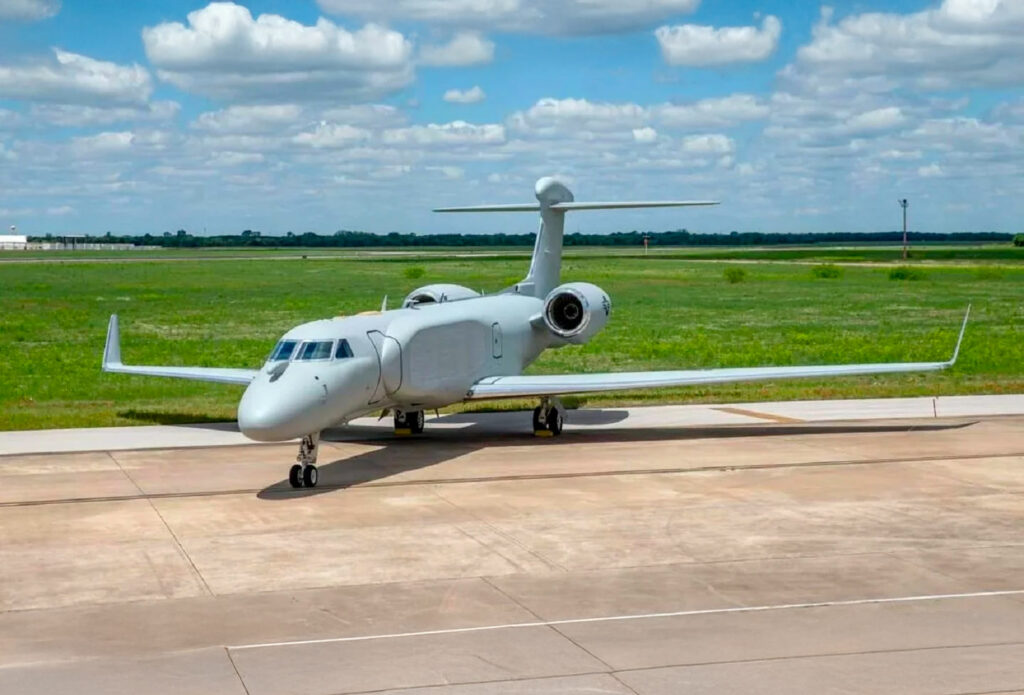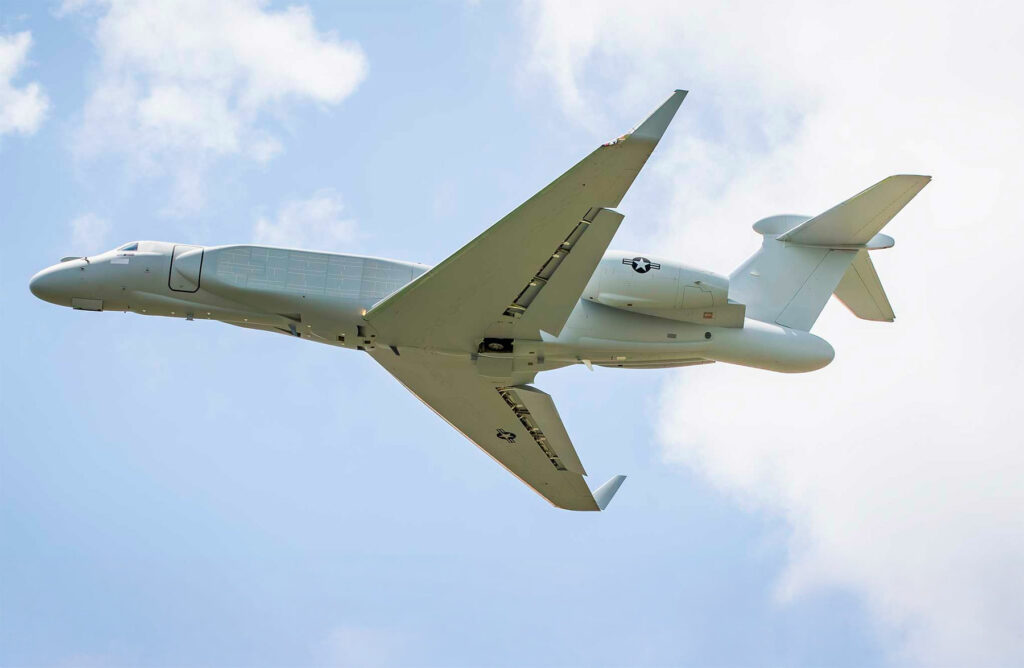The EC-37B Compass Call is an advanced electronic warfare aircraft developed by BAE Systems, utilizing a modified Gulfstream G550 airframe to deliver enhanced electromagnetic attack capabilities.
The EC-37B Compass Call is a state-of-the-art electronic warfare aircraft developed by BAE Systems for the U.S. Air Force. Built upon a modified Gulfstream G550 airframe, it replaces the aging EC-130H platform. The EC-37B is powered by two Rolls-Royce BR710 C4-11 turbofan engines, each producing 15,385 pounds (68.44 kN) of thrust. The aircraft measures 96 feet 5 inches (29.4 meters) in length, with a wingspan of 93 feet 6 inches (28.5 meters), and a height of 25 feet 10 inches (7.9 meters). It has an empty weight of 48,300 pounds (21,909 kilograms) and a maximum takeoff weight of 98,000 pounds (44,452 kilograms). The EC-37B achieves a maximum speed of 767 mph (1,234 km/h) and operates at a service ceiling of 45,000 feet (14,000 meters). Its range extends to 4,410 miles (7,100 kilometers). The aircraft accommodates a crew of up to nine, including two pilots and up to seven mission specialists. Equipped with advanced electronic attack systems, the EC-37B disrupts enemy communications, radar, and navigation systems, enhancing the U.S. Air Force’s capabilities in electromagnetic warfare.
History of the Development of the BAE Systems EC-37B Compass Call
In the early 1980s, the U.S. Air Force introduced the EC-130H Compass Call, an electronic warfare aircraft designed to disrupt enemy communications and radar systems. Based on the C-130 Hercules airframe, the EC-130H served effectively for decades, participating in various conflicts and undergoing multiple upgrades to address evolving threats. However, by the early 2000s, the increasing sophistication of adversary technologies and the aging C-130 platform highlighted the need for a more advanced and capable replacement.
In 2014, the U.S. Air Force proposed retiring the EC-130H fleet, recognizing the necessity for a modern platform that could meet current and future electronic warfare requirements. This led to the initiation of the Compass Call Rehost program, aiming to transfer the existing mission systems from the EC-130H to a more advanced airframe. After evaluating various options, the Gulfstream G550 business jet was selected as the new platform due to its superior speed, altitude capabilities, and adaptability for mission modifications.
In 2017, L3Harris Technologies was awarded the contract to serve as the lead systems integrator for the new Compass Call aircraft, designated as the EC-37B. BAE Systems was tasked with developing and integrating the electronic warfare systems, while Gulfstream Aerospace provided the G550 airframes. The program’s objective was to enhance electronic attack capabilities, improve survivability, and ensure the flexibility to counter emerging threats.
The EC-37B’s development involved significant modifications to the G550 airframe to accommodate advanced electronic warfare equipment. This included structural reinforcements, installation of specialized antennas, and integration of mission systems. The first EC-37B aircraft was delivered to the U.S. Air Force in September 2023 for developmental and operational testing. The initial operating capability is anticipated to be achieved in 2026, marking a new era in the U.S. Air Force’s electronic warfare operations.

Design of the BAE Systems EC-37B Compass Call
The EC-37B Compass Call is built upon the Gulfstream G550 airframe, a platform renowned for its performance and reliability. The aircraft measures 96 feet 5 inches (29.4 meters) in length, with a wingspan of 93 feet 6 inches (28.5 meters), and a height of 25 feet 10 inches (7.9 meters). Its empty weight is 48,300 pounds (21,909 kilograms), and it supports a maximum takeoff weight of 98,000 pounds (44,452 kilograms).
The choice of the Gulfstream G550 airframe provides the EC-37B with several advantages over the EC-130H Compass Call. The G550 operates at a higher altitude, allowing for better signal coverage and reducing vulnerability to ground-based threats. The aircraft’s increased speed enhances its survivability by allowing it to reposition rapidly in response to changing battlefield conditions. Additionally, the modern avionics suite of the G550 offers improved situational awareness for the crew.
One of the major modifications involves structural reinforcements and the integration of multiple external antenna arrays for electronic attack operations. These antennas are strategically positioned to optimize radio frequency jamming and disruption capabilities. The aircraft’s electronic warfare suite is tailored to counter enemy radar, communication networks, and datalinks, making it a critical component of U.S. Air Force operations.
The EC-37B also benefits from a modular design, enabling future upgrades without requiring extensive airframe modifications. This design ensures that the aircraft remains relevant as adversary technologies evolve. The adoption of the G550 airframe also reduces operating costs compared to the EC-130H, which required higher maintenance and fuel consumption.
A drawback of the EC-37B compared to its predecessor is its smaller size, which limits onboard crew capacity. The EC-130H accommodated a larger mission crew, whereas the EC-37B operates with a reduced number of electronic warfare officers. However, this is mitigated by the aircraft’s advanced automation and improved data processing capabilities, which reduce workload while increasing efficiency.
The EC-37B Compass Call represents a major leap forward in electronic warfare aircraft design, combining higher performance, modern avionics, and enhanced electronic attack capabilities within a compact, high-speed platform.
Performance of the BAE Systems EC-37B Compass Call
The EC-37B Compass Call is powered by two Rolls-Royce BR710 C4-11 turbofan engines, providing 15,385 pounds (68.44 kN) of thrust per engine. This configuration enables a maximum speed of 767 mph (1,234 km/h), significantly improving the response time compared to the EC-130H Compass Call, which had a top speed of 300 mph (482 km/h).
Speed and Altitude
The EC-37B operates at a service ceiling of 45,000 feet (13,716 meters), compared to 25,000 feet (7,620 meters) for the EC-130H. This increase in altitude allows the aircraft to operate above most commercial air traffic and certain air defense threats, improving mission effectiveness and survivability.
Range and Endurance
The aircraft has a range of 4,410 miles (7,100 kilometers), allowing for long-duration missions without requiring frequent aerial refueling. This extended range is a major advantage over the EC-130H, which had a range of 2,295 miles (3,693 kilometers). The EC-37B’s fuel efficiency contributes to its operational endurance, ensuring that missions can be conducted over vast operational areas without frequent interruptions.
Electronic Warfare Capabilities
The EC-37B Compass Call is equipped with advanced electronic attack (EA) systems, designed to jam and degrade enemy radar, communications, and navigation signals. The aircraft is particularly effective against enemy integrated air defense systems (IADS), battlefield communication networks, and tactical datalinks.
The Compass Call system on the EC-37B features an open-architecture design, allowing for continuous software and hardware upgrades. This ensures that the aircraft remains effective against emerging threats, including adaptive enemy radar systems and encrypted communication channels.
Survivability
While the EC-37B is not equipped with conventional weaponry, its electronic warfare capabilities serve as its primary defense. By disrupting enemy radar and targeting systems, the aircraft can reduce the effectiveness of surface-to-air missile (SAM) systems and air interceptors.
The aircraft is also equipped with self-protection countermeasures, including electronic countermeasures (ECM), chaff, and flare dispensers. These systems enhance its ability to evade tracking and targeting by enemy air defenses.
Comparison to Competitors
Compared to foreign electronic warfare platforms, such as the Russian Il-22PP Porubshchik and Chinese Y-9G, the EC-37B benefits from greater speed, altitude, and modular upgrade potential. While the Il-22PP operates on a much older Il-18 airframe, and the Y-9G is based on the Y-9 cargo aircraft, the EC-37B’s Gulfstream G550 platform provides superior efficiency, speed, and agility.
The EC-37B Compass Call significantly improves upon the EC-130H, providing the U.S. Air Force with a faster, more survivable, and more adaptable electronic warfare platform.

Variants of the BAE Systems EC-37B Compass Call
The EC-37B Compass Call is currently the only major variant of the Compass Call program. However, the development of the EC-37B involved the following significant modifications:
- Baseline G550 Platform: Before modifications, the EC-37B began as a standard Gulfstream G550 business jet, which underwent structural modifications to accommodate electronic warfare equipment.
- EC-37B Configuration: The aircraft received a specialized electronics suite from BAE Systems, including missionized antennas, upgraded avionics, and electromagnetic warfare systems.
- Future Variants: While no official future variants have been announced, the EC-37B’s modular system architecture allows for rapid upgrades, meaning it may receive software and hardware enhancements as electronic warfare technology advances.
Military Use and Combat of the BAE Systems EC-37B Compass Call
The EC-37B Compass Call has not yet been deployed in combat, as it is currently undergoing testing and integration. However, the aircraft is intended to replace the EC-130H Compass Call, which has been used in multiple military operations, including:
- Operation Desert Storm (1991): The EC-130H Compass Call played a crucial role in jamming Iraqi communication networks, limiting enemy coordination.
- Operations in Afghanistan (2001-2021): The aircraft was used to disrupt Taliban and Al-Qaeda communications.
- Operations in Syria and Iraq (2014-Present): Used to counter ISIS command and control networks.
Given its advanced capabilities, the EC-37B is expected to play a similar role in future conflicts, enhancing electronic attack operations.
The U.S. Air Force is currently the only known operator of the EC-37B, and there have been no foreign sales due to its sensitive technology.
The BAE Systems EC-37B Compass Call represents a significant advancement in airborne electronic warfare. Replacing the EC-130H, it introduces superior speed, altitude, and adaptability through its Gulfstream G550 airframe. The EC-37B enhances electronic attack capabilities, ensuring the U.S. Air Force maintains a strategic advantage in electromagnetic warfare. As adversaries develop countermeasures, the aircraft’s modular open-architecture system ensures its long-term viability. While combat deployment is pending, the EC-37B’s design and capabilities make it one of the most sophisticated electronic warfare aircraft in modern aviation.
Back to the Special Aircraft section